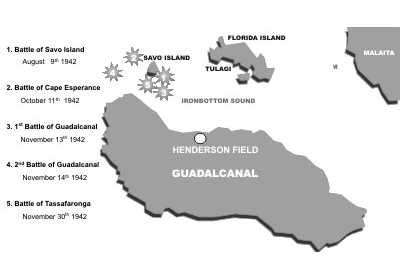- Author
- Dunne, Mike
- Subjects
- Biographies and personal histories, WWII operations, History - WW2
- Tags
-
- RAN Ships
- None noted.
- Publication
- March 2006 edition of the Naval Historical Review (all rights reserved)
Impatient for a decision, the Japanese brought their main fleet south and engaged the new American commander, Vice-Admiral William F. Halsey, off Santa Cruz on 26 October. Though suffering a prohibitively expensive toll in aircraft and pilots, the Japanese succeeded in adding the carrier USS Hornet to the cost of Guadalcanal.
During the first 10 days of November alone Tanaka ran 65 destroyer sorties, his achievement being to see his side outnumber the Americans ashore by 30,000 to 29,000. The cost was three destroyers damaged.
On 12 November the Japanese brought down 11,000 men in transports, covered by a force that included two battleships. American intelligence was 9,000 and they were ready but the battle, early on 13 November, degenerated into a confused melee, the Americans losing four destroyers and two cruisers for one Japanese battleship and two destroyers. Undeterred, the Japanese returned during the following night, the airfield again being swept by 1,400 assorted cruiser and destroyer rounds in the space of 37 minutes. With daylight Henderson-based aircraft caught the culprits, sinking a heavy cruiser, but they had diverted attention from the ‘Express’ which had run in no less than 10 transports. Six were lost to frantic air attack and the remainder beached to guarantee their deliveries. The enemy certainly did not lack resolve. A heavy covering force also came down ‘The Slot’ and was met by a similar American force near Savo island.
Ironbottom Sound
The battle-cruiser Kirishima was overwhelmed by gunfire from the battleship USS Washington, and together with two American and one Japanese destroyer laid her bones alongside the remainder already littering what was now known as Ironbottom Sound.
The cost had resulted in only 2,000 of 7,000 Japanese troops actually being landed. The Americans now outnumbered their foe by 40,000 to 25,000 and only Tanaka could prevent disaster. His overworked destroyers were reduced to delivering supplies by rubberized containers, pushed overboard to be floated ashore with the tide.
During the night of 30 November eight of his destroyers, cluttered with supplies and personnel, were surprised by an American force of five cruisers and six destroyers off Tassafaronga. The seasoned Japanese reacted instinctively and freely with torpedoes, while the less experienced Americans betrayed their positions by reliance on radar-laid gunfire. Four cruisers were torpedoed, one was lost. Tanaka lost one destroyer but had turned a potential defeat into victory and still delivered ‘the goods.’
Early December saw a spate of runs by up to 10 destroyers at a time, then on 12 December the destroyer Teruzuki was lost to a PT boat’s torpedoes. Somewhat battered and bereft of air cover, the Japanese called a halt until the next moonless phase in early January 1943. By now the Japanese high command had resolved that Guadalcanal be evacuated as ‘untakable’ and on 14 January 1943 the Tokyo Express ran in 600 crack troops to act as rearguard. The evacuation itself was, unbelievably, not opposed in three operations early February. The TE used a cruiser and 20 destroyers to remove every last soldier; the Americans either did not appreciate the position or were just relieved to see the back of the Japanese, the only loss being a mined destroyer.
The island had cost the Americans about 1,600 troops and many more sailors; the Japanese had lost over 23,000. Both sides had lost 24 ships apiece of destroyer size and above in numerous skirmishes and seven major actions. The Japanese fleet, experienced but outnumbered, acquitted itself admirably; while the Americans, starting as ‘rookies’, stuck to their task, eventually emerging not only victorious but much the wiser.
Setback for Japan
The fall of Guadalcanal was a stunning setback for Japan. For the first time in the war, the Japanese had been defeated decisively on ground, air and sea.
For the Americans, difficult fighting still lay ahead, and they would suffer many more tactical defeats at the hands of the IJN as battles in the Solomons continued. Yet with the Guadalcanal victory the momentum of the Pacific war had shifted decisively to the Allies.

Despite his successes against long odds, Tanaka had by this time made himself highly unpopular with his superiors, mainly because of his outspoken criticism of Japanese strategy and tactics in the Solomons – not to mention Midway.
In particular, he argued long and forcefully for the early abandonment of Guadalcanal. As a result, his wounds were used as an excuse to transfer him to Singapore, and in 1943 he was given a shore command in Burma. He was never again to command units at sea, despite his track record in combat.
He survived the war to become active in the IJN Destroyer Association and to serve in Japan’s post-war Navy. He died in 1975, no doubt proud of his service to his country.




